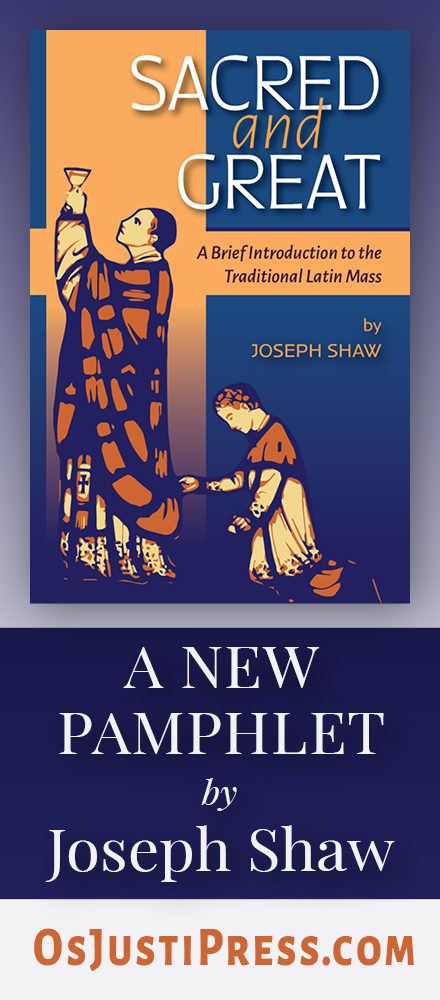The blog of Catholic Extension magazine has posted links to a whole series of reproductions of pages from an edition of the magazine printed in 1943. Each of them contains a series of paper-dolls, including a priest, an altar boy, and everything necessary for Mass and Benediction; there is even an altar, with the candlesticks and monstrance, a Missal and a tabernacle, right down to the purificator. The vestments are left uncolored, so children can choose for themselves the liturgical color they like. Along with the paper-dolls themselves are explanations in some detail of the history, meaning and use of various aspects of the liturgical tradition. I found these interesting also because they show the high level of education back in the day; the author of these explanations can write things on the order of, “The altar must be of stone, and in this it also represents Christ, for St Paul tells of the Israelites drinking water from the rock, and says that the rock was Christ,” without fear of going over his readers’ little heads. Children are instructed to keep the left-hand part of each page as a little liturgical textbook. Depending on your age, you can also use these to show your children or grandchildren, what your parents, or you yourself, played with, back when there were no video games, and dinosaurs and saber-toothed tigers roamed the Earth... (h/t to our friend Roseanne Sullivan.)
Wednesday, October 22, 2014
More recent articles:
The Chrism Mass: Tradition, Reform and Change (Part 1) - Guest Article by Abbé Jean-Pierre HermanGregory DiPippo
We are very grateful to Fr Jean-Pierre Herman for sharing with us this important article about the Chrism Mass and its recent reforms. The French original was published two days ago on the website of the Schola Sainte-Cécile as a single article; it will be published here in two parts. Fr Herman is professor of liturgy at the Good Shepherd Institute...
The 2nd Adeodatus Conference on Catholic Education, June 18-21 at Belmont Abbey CollegeDavid Clayton
Find out more and register here.This four-day gathering brings together educators, scholars, and Catholic thought leaders to explore the integral formation of students and teachers in mind, body, and spirit. Each day will focus on a distinct theme, beginning with Sound Bodies & Keen Minds, addressing topics like memory, mimesis, and freedom fro...
Guest Review of Mons. Stefan Heid’s Altar and Church: Principles of Liturgy from Early ChristianityGregory DiPippo
We are grateful to Dr Michael Coughlin, Professor of Theology at Saint John’s Seminary in Boston, for sharing with NLM this review of Monsignor Stefan Heid’s book Altar and Church: Principles of Liturgy from Early Christianity. Mons. Heid is a priest of the archdiocese of Cologne, Germany; he has taught liturgy and hagiography at the Pontific...
A Liturgical Oddity of Holy MondayGregory DiPippo
In the Missal of St Pius V, there is a very small number of days on which two Scriptural lessons are read before the Gospel: the Wednesdays of the Embertides, of the fourth week of Lent and Holy Week, and Good Friday. As I have described elsewhere, these readings are actually part of a block which is inserted into the Mass between the Kyrie and the...
Palm Sunday 2025Gregory DiPippo
Thou didst incline the heavens, and come down to the earth as one merciful. Thou didst not leave the throne of the Cherubim, Thou sat upon a colt for our sake, o Savior of the world! And the children of the Hebrews came to meet Thee, and taking palms in their hands, they blessed Thee: “Blessed art Thou who hast come to the Passion of Thy own ...
Superb Recordings of the Hymns of PassiontideGregory DiPippo
As we are about to enter Holy Week, here are two genuinely outstanding recordings of the hymns for Passiontide Vexilla Regis and Pange lingua. These come from an album released by the choir of Westminster Cathedral in October of 2023, titled Vexilla Regis: A sequence of music from Palm Sunday to Holy Saturday; the 21 tracks are also ...
The Mass of Passion Thursday - ContinuedGregory DiPippo
In yesterday’s article, I described the Roman station church of Passion Thursday as a place of exile for Eastern iconodule monks whom the persecution of the iconoclast Byzantine emperors had driven into Italy. This basilica is dedicated to St Apollinaris, the first bishop of Ravenna, who is traditionally said to have been a disciple of St Peter, se...
The Offertory Incensation, Part IIMichael P. Foley
Cardinal Hayes incensing the altar at the opening Mass for the 7th National Eucharistic Congress at the Public Auditorium in Cleveland, 1935Lost in Translation #123 When the priest incenses the altar, he recites Psalm 140, 2-4: Dirigátur, Dómine, oratio mea, sicut incensum in conspectu tuo: Elevatio manuum meárum sacrificium vespertínum. Pone, Dó...
A Choirmaster’s Reflections on the Twelve Passion Gospels: Guest Article by Fr. Herman MajkrzakGregory DiPippo
One of the most powerful services of the extremely rich Byzantine Holy Week is Matins of Great and Holy Friday, known as the Matins of the Twelve Gospels. This consists of the (mostly) regular order of Matins as it is celebrated in Lent, into which Twelve Gospel readings of the Lord’s Passion are added at various points. I am very grateful to my fr...
The Anti-Iconoclast Mass of Passion ThursdayGregory DiPippo
Today’s Divine Office contains an unusual feature: the antiphons of the Benedictus and Magnificat are not taken from the Gospel of the Mass (Luke 7, 36-50), as they are on nearly every other day of Lent. Instead, the former is taken from the Passion of St Matthew (26, 18), “The master saith, ‘My time is near at hand, with thee I keep the Pasch with...





















